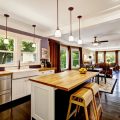Introduction to British Building Standards on Daylight
Daylight provision is a crucial element within the realm of building design and maintenance across the United Kingdom. Ensuring that buildings receive adequate natural light not only enhances occupant comfort and wellbeing, but also supports energy efficiency by reducing reliance on artificial lighting. In the context of British building regulations, daylight provision is carefully considered as part of planning and compliance processes, with specific standards set out to guide architects, builders, and property owners. The importance placed on daylight reflects both health and environmental priorities, making it a key aspect of sustainable construction practices throughout the UK. Understanding these regulations and their practical implications is essential for anyone involved in building projects, property maintenance, or renovation works within the country.
2. Key Regulations and Guidance Documents
When it comes to ensuring adequate daylight provision in British buildings, a range of regulations and guidance documents must be considered. These statutory requirements and best-practice guidelines are designed not only to enhance occupant wellbeing but also to improve energy efficiency and sustainability within the built environment.
Main Statutory Requirements
The foundation of daylight standards in the UK is set out in several Approved Documents under the Building Regulations, as well as relevant British Standards. The most pertinent documents include:
| Document | Focus Area | Key Relevance to Daylight Provision |
|---|---|---|
| Approved Document Part O (Overheating) | Thermal comfort & overheating risk | Considers daylight when assessing potential for overheating due to solar gain |
| Approved Document Part L (Conservation of Fuel and Power) | Energy efficiency | Promotes the use of daylight to reduce artificial lighting demand, impacting carbon emissions |
| Approved Document Part F (Ventilation) | Indoor air quality & ventilation | Daylight is often linked with window design, which affects both light and ventilation performance |
British Standards and Best-Practice Guidelines
Apart from statutory regulations, BS 8206-2:2008 “Lighting for buildings – Code of practice for daylighting” provides technical guidance on achieving good daylight levels. This document outlines recommendations for average daylight factors (ADF), room depth ratios, and window placement to ensure comfortable, well-lit spaces.
Summary of Key Daylighting Criteria in BS 8206-2
| Criterion | Recommended Value/Approach |
|---|---|
| Average Daylight Factor (ADF) | >2% for kitchens, >1.5% for living rooms, >1% for bedrooms |
| Room Depth Ratio | No greater than 2 times the window head height from the window wall for effective daylight distribution |
Practical Application in Maintenance and Refurbishment
For those involved in building maintenance or refurbishment, understanding these requirements is crucial. Regular inspections should check that glazing remains unobstructed, frames are clean, and any interior alterations do not compromise compliance with daylight standards. When replacing windows or carrying out upgrades, referencing the latest Approved Documents and BS 8206-2 ensures continued adherence to UK best practice.

3. Assessing Daylight in New and Existing Buildings
When it comes to adhering to British building standards for daylight provision, a rigorous assessment process is essential for both new developments and the refurbishment of existing properties. This ensures that buildings not only comply with regulations but also provide healthy and comfortable environments for occupants. Understanding the methods and criteria used in these assessments is crucial for anyone involved in design, construction, or maintenance.
Common Methods for Evaluating Daylight Provision
The most frequently employed method in the UK is the Daylight Factor (DF). The DF is expressed as a percentage and represents the ratio of internal illuminance at a specific point inside a room to the simultaneous outdoor illuminance under overcast sky conditions. According to Approved Document O and BS 8206-2:2008, a minimum average daylight factor of 2% is typically recommended for kitchens, with 1.5% suitable for living rooms and bedrooms. This metric provides a reliable baseline when assessing whether spaces receive adequate daylight under typical British weather conditions.
Illuminance Measurements
Another practical criterion involves measuring illuminance levels directly within the space, often using lux meters or computer simulations. Target values are generally set around 100–300 lux for habitable rooms during daylight hours. These measurements help determine not only compliance with standards but also support decisions on artificial lighting requirements, contributing to energy efficiency and occupant well-being.
Application in Refurbishment vs. New Builds
In new builds, architects and engineers can optimise window placement, glazing type, and interior finishes from the outset to maximise natural light penetration. In contrast, refurbishment projects may face constraints due to existing structures. Here, assessments often highlight areas where interventions—such as enlarging window openings or specifying light-reflective surfaces—can enhance daylight availability while maintaining compliance with current guidelines.
Practical Considerations on Site
On-site assessment remains fundamental in both scenarios. For refurbishments especially, site surveys allow for an accurate appraisal of obstructions (like neighbouring buildings or vegetation), which can impact available daylight. Building professionals must balance regulatory requirements with practical considerations—ensuring that solutions are feasible and sympathetic to the building’s character, especially where heritage assets are concerned.
Taken together, these methods provide a structured approach to evaluating daylight provision according to British standards, supporting sustainable design choices that benefit both building users and owners over the long term.
4. Design Considerations for Maximising Daylight
In the context of British building standards and regulations, ensuring optimal daylight provision requires a balanced approach that factors in both compliance and occupant comfort. Architects and designers in the UK employ several strategies, select specific materials, and incorporate architectural features to enhance daylight penetration while still adhering to Building Regulations Approved Document Part O and BS 8206-2:2008 guidelines.
Strategic Design Approaches
Effective daylighting begins at the earliest stages of design. Key considerations include building orientation, room depth, window placement, and internal layout. In Britain’s often overcast climate, south-facing windows are generally preferred to maximise solar gain throughout the year. However, glare control and overheating must also be managed, especially in compliance with Part O requirements on thermal comfort.
Material Choices for Daylighting
| Material | Benefits | Common Applications |
|---|---|---|
| Low-Iron Glass | Improved clarity and light transmission compared to standard glass. | Windows, skylights, curtain walls |
| Light-Reflective Paints | Enhances internal reflectance, boosting daylight distribution deeper into spaces. | Ceilings, upper wall surfaces |
| Louvred Blinds/Shading Devices | Controls glare and heat gain without sacrificing natural light entry. | South/east-facing windows |
| Translucent Panels | Diffuse harsh sunlight while maintaining privacy and daylighting levels. | Corridors, stairwells, façade elements |
Architectural Features Enhancing Daylight Access
Several architectural interventions are commonly integrated within British buildings to maximise natural illumination:
- Lightwells: Vertical shafts introduced into deeper floor plans to channel daylight from roof level down to ground or basement areas.
- Clerestory Windows: High-level glazing that introduces daylight above eye level, reducing reliance on artificial lighting during daytime hours.
- Atriums: Central open spaces capped with glazed roofs, providing abundant daylight to adjacent rooms and communal zones while supporting compliance with minimum daylight factor recommendations.
- Open-Plan Layouts: Reducing internal partitions allows more even distribution of light from perimeter windows across larger floor plates.
Balancing Daylight with Regulatory Compliance
The integration of these design strategies is always considered alongside British building standards. For example, window sizes and placements are calculated based on recommended average daylight factors (typically 2% for habitable rooms) as per BS 8206-2. Meanwhile, thermal performance is addressed through careful specification of glazing U-values and the use of appropriate shading systems to avoid excessive solar gains outlined under Part L and Part O requirements. This holistic approach not only ensures regulatory compliance but also contributes to energy efficiency, occupant wellbeing, and long-term structural integrity of the built environment.
5. Daylight, Health, and Occupant Wellbeing
Daylight is increasingly recognised in the UK as a fundamental factor influencing building occupants health, comfort, and overall wellbeing. Modern research and policy guidance emphasise that sufficient access to natural light within homes, workplaces, and public buildings can significantly enhance quality of life. The British Standards Institution (BSI) and related regulations such as Approved Document O and BS EN 17037 highlight not only minimum daylight levels but also their broader impact on physical and mental health.
The Role of Daylight in Comfort and Productivity
Proper daylight provision reduces reliance on artificial lighting, which can help mitigate eye strain and fatigue often associated with poorly lit environments. Numerous studies conducted across the UK have found that well-daylit spaces are strongly linked to improved concentration and productivity among occupants—particularly relevant for schools, offices, and healthcare facilities. These findings are echoed in recommendations from Public Health England, which advises designers to maximise daylight access while controlling glare and overheating risks.
Mental Wellbeing and Circadian Rhythms
Natural daylight exposure plays a crucial role in regulating circadian rhythms—the internal body clock governing sleep-wake cycles. Insufficient daylight has been associated with increased rates of seasonal affective disorder (SAD) and other mood disturbances, especially during the darker winter months typical of the UK climate. Building standards now encourage design solutions that maximise daylight penetration deep into living spaces to support healthy daily routines and mental resilience.
Reflecting UK Policy Initiatives
The latest updates in British building regulations reflect a holistic approach: they integrate scientific evidence about daylights effects on wellbeing into practical benchmarks for new builds and refurbishments. Planners and designers are encouraged to assess daylight not just by quantity but also by distribution, duration, and quality throughout the day. By aligning regulatory frameworks with current research, the UK construction sector aims to deliver built environments that actively promote comfort, efficiency, and occupant health for years to come.
6. Common Challenges and Practical Solutions
Addressing Heritage Constraints
In the UK, many buildings are listed or situated in conservation areas, where strict heritage regulations govern alterations, including changes to windows and daylight openings. To comply with both daylight standards and heritage requirements, it is essential to work closely with local planning authorities and conservation officers from the outset. Consider installing secondary glazing or using traditional materials and methods that retain the building’s character while improving daylight provision. Consulting with heritage specialists can help balance compliance and preservation.
Navigating Urban Density
Urban development across British cities often leads to increased density, resulting in overshadowed spaces and reduced access to natural light. When planning new builds or refurbishments, use advanced daylight modelling tools during the design phase to predict potential issues. Solutions such as strategically placed rooflights, lightwells, or clerestory windows can help maximise available daylight without compromising privacy or site constraints. Where feasible, consider shared amenity spaces that benefit from optimal orientation and larger window openings.
Ensuring Compliance in Constrained Sites
Limited plot sizes and proximity to neighbouring properties frequently make achieving required daylight levels challenging under current British Standards. Collaborate early with architects, engineers, and daylight consultants to explore options like high-performance glazing, reflective internal finishes, and open-plan layouts that promote light penetration deeper into the building.
Maintenance and Long-Term Performance Tips
Daylight performance can degrade over time due to factors such as dirt accumulation on glazing, deterioration of window seals, or changes in surrounding environments (like new adjacent developments). Establish a regular cleaning schedule for all glazed surfaces and inspect seals for wear or condensation build-up. Encourage occupants or building managers to maintain unobstructed window areas by avoiding heavy curtains or placing large furniture directly in front of windows. Additionally, plan for periodic reviews of external site conditions to anticipate any future obstructions caused by nearby construction.
Summary of Practical Advice
Successfully navigating the typical challenges of British building projects—heritage constraints, urban density, and ongoing maintenance—requires early engagement with relevant authorities, careful design planning using up-to-date modelling tools, and a commitment to long-term care of daylight features. By combining regulatory compliance with practical maintenance strategies, you can ensure lasting daylight quality and occupant satisfaction throughout your building’s lifecycle.
7. Conclusion and Resources for Further Guidance
Summary of Key Points
Ensuring adequate daylight provision in buildings is a fundamental requirement under British building standards, directly impacting occupant comfort, health, and energy efficiency. Throughout this guide, we have reviewed how UK regulations—most notably the Building Regulations (Approved Document Part O and Part L), BS 8206-2:2008, and BRE guidelines such as “Site Layout Planning for Daylight and Sunlight”—set clear criteria for daylight levels in residential and commercial spaces. By adhering to these standards during design, construction, and maintenance phases, property owners and professionals can secure compliance while promoting sustainable and habitable environments.
Additional Resources
Official Publications & Guidance
- UK Government Building Regulations: gov.uk – Approved Documents
- BRE Trust: BRE Group Publications, including the definitive “Site Layout Planning for Daylight and Sunlight: A Guide to Good Practice”
- British Standards Institution (BSI): BSI Shop – e.g., BS 8206-2:2008 Lighting for Buildings
Professional Bodies & Support Channels
- The Royal Institute of British Architects (RIBA): architecture.com
- The Chartered Institute of Building (CIOB): ciob.org
- Planning Portal: planningportal.co.uk
Staying Updated with Compliance Requirements
The landscape of building regulations evolves regularly to reflect advancements in technology, environmental standards, and occupant wellbeing. For ongoing compliance with UK daylight regulations, it is essential to consult the latest government updates and seek professional advice when planning or modifying properties. Engage with your local authority’s building control department for project-specific queries, and consider membership in relevant professional bodies for continuous development and support. By leveraging these resources, stakeholders can confidently maintain high standards in daylight provision within Britain’s built environment.

